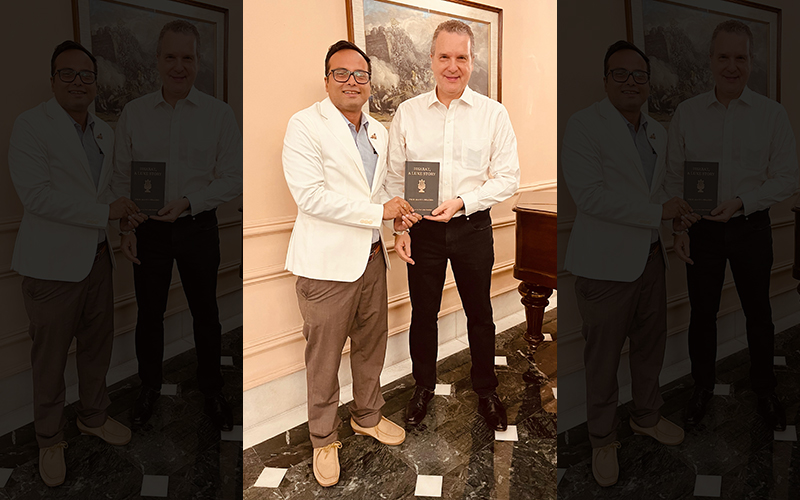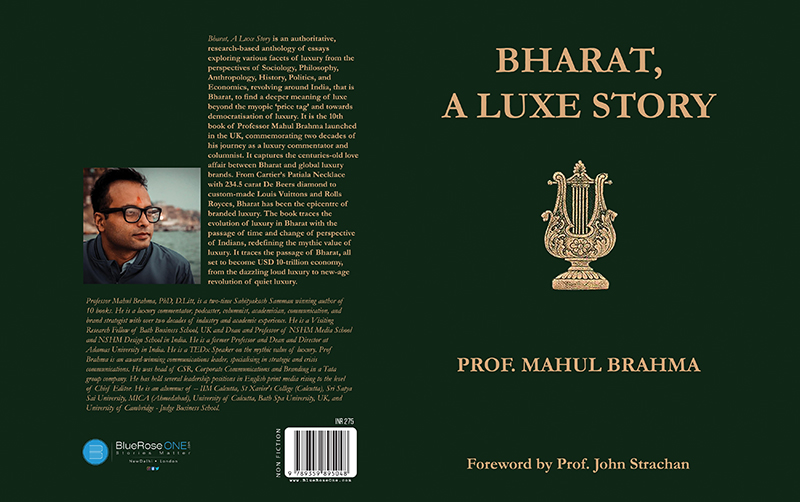
My new book traces evolution of luxury in Bharat: academician Mahul Brahma
Mahul Brahma, Dean & Professor at NSHM Media School & NSHM Design School and a Fellow of the Bath Business School UK, has come up with his tenth book Bharat, A Luxe Story that was launched in Kolkata by Ambassador of Brazil to India.
Excerpts of a conversation with the writer
Tell us a bit about the book.
Bharat, A Luxe Story is an authoritative, research-based anthology of essays exploring various facets of luxury from the perspectives of Sociology, Philosophy, Anthropology, History, and Economics, revolving around India, that is Bharat, to find a deeper meaning of luxe beyond the myopic ‘price tag’. It is my 10th book, commemorating two decades of my journey as a luxury columnist and commentator. It captures the centuries-old love affair between Bharat and global luxury brands. From Cartier’s Patiala Necklace to custom-made Louis Vuittons and Rolls Royces, Bharat has been the epicentre of branded luxury. The book traces the evolution of luxury in Bharat with the passage of time and change of perspective of Indians, redefining the mythic value of luxury. It traces the passage of Bharat, all set to become USD 10-trillion economy, from the dazzling loud luxury to new-age revolution of quiet luxury.
Please share some glimpses of this “centuries-old affair” between luxury brands and India in your book.
In Bharat, the love affair between luxury brands and showcasing of luxury reached the pinnacle during the 1920s when India alone was consumer of 20 per cent of global sales of Rolls Royce or when a certain Nizam had 50 Harley Davidsons for his personal messengers or when Zebra-driven phaetons used to give competition to the horse-driven carriages.
Surprised? Picture this: it is estimated that over roughly 200 years, the East India Company and the British Raj siphoned out at least GBP 9.2 trillion (or DLR 44.6 trillion; since the exchange rate was DLR 4.8 per GBP during much of the colonial period).
In 1926, the Maharaja of Patiala commissioned Cartier, its largest till date, to remodel his crown jewels, which included the 234.69 carat De Beers diamond. The result was a breath-taking Patiala necklace weighing 962.25 carats with 2,930 diamonds.

You have a special love for Rolls Royce and it has been a recurring theme in all your books. Can you share an interesting example with us?
Okay, so let’s talk about an interesting royalty story of the brand that runs on reputation -- Roll Royce. In my second book Dark Luxe, I have shared a great example in the story ‘Death of a Phantom’ of Maharaja Jai Singh buying the epitome of reputation in Western culture – Rolls Royce, six of them, and converting them into garbage vans for the city. Maharaja Jai Singh visited London and was wearing casual dress. During his city tour, he spotted the Rolls Royce showroom and entered it to know more about the cars and even buy the vehicle. However, seeing his “native Indian” appearance, the security of the showroom assumed that he is a beggar and did not allow him to enter the showroom. Thus he purchased and converted all six Rolls Royce cars into garbage collectors for his kingdom. It is as loud as it gets!
Therefore, luxury, especially in the context of royalty in Bharat was never “quiet” or subliminal but always “loud” and on the face. The evolution of luxury in Bharat has seen an elaborate dominance of logos as seen with flaunters.
How was your experience with the Ambassador of Brazil to India, who launched your book in Kolkata?
The Ambassador of Brazil, HE Kenneth Feli Haczynski Da Nobrega, has been very kind to make time from his busy schedule to show his support for Bharat, A Luxe Story. He was very surprised with the anecdotes of royalty in Bharat who were the biggest customers of luxury brands. He was also quite interested in the phenomenon of quiet luxury and so I gifted him a copy of my book on it – The Quiet Luxe. He also wrote me a note wishing success to the book. He had started reading it and said he will give his detailed feedback once he completes it. I eagerly await his feedback.
Can you share a bit on that and also the upcoming launch of the book in the UK later this year.
Professor John Strachan, Pro VC of Bath Spa University, UK has written the foreword for Bharat, A Luxe Story. Prof Strachan will be launching the book in UK later this year during my yearly visit to Bath Spa University as a Visiting Research Fellow. Incidentally, Professor Strachan had launched my earlier book Aesthetic Leadership in Luxury last year in the city of Bath in the UK. I look forward to that launch.
Support Our Journalism
We cannot do without you.. your contribution supports unbiased journalism
IBNS is not driven by any ism- not wokeism, not racism, not skewed secularism, not hyper right-wing or left liberal ideals, nor by any hardline religious beliefs or hyper nationalism. We want to serve you good old objective news, as they are. We do not judge or preach. We let people decide for themselves. We only try to present factual and well-sourced news.







